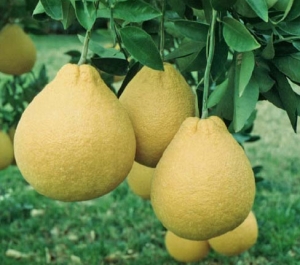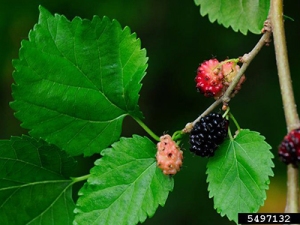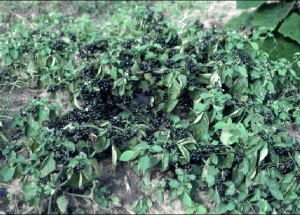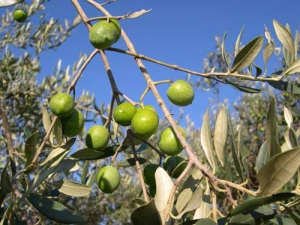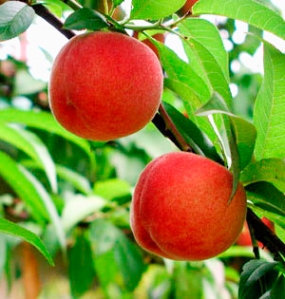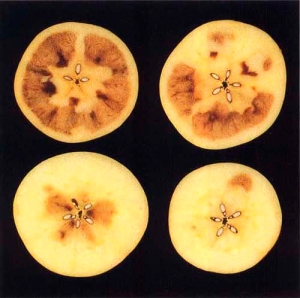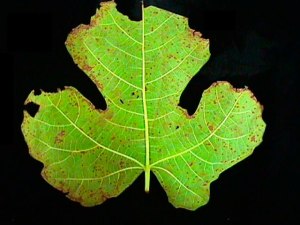A: Pummelo, Citrus maxima, looks similar to a grapefruit but quite different. It is a very large, round to pear-shaped, yellowish orange fruit with very thick rind. The fruit is so large there have been records of fruit weighing up to 20 pounds; however each fruit is more typically around 5 pounds. Still, it is a large single fruit to hang from a tree by anyone’s standards. Although it looks similar to a grapefruit the flesh is sweeter and less bitter. Because of the size of the fruit and the thick rind it is generally not a consumer favorite. Thus, you many have some difficulty finding it in local grocery markets or plant nurseries. Once the thick rind is removed the flesh divides easily into separate sections. Although it is important to also note the sections may differ in size and form on some of the pummelo cultivars. The tree can grow to heights of 30 feet with an equally wide spread so consider its mature size when planting it in the landscape. Pummelo is typically grown in cold hardiness zone 9-11. When planting in the landscape provide as much sun exposure as possible but avoid areas where wind could be an issue. Some of the more common varieties of pummelo include: Chandler, Ichang, Red Shaddock, Reinking, and Webber. There are three new cultivars of pummelo which have been released to Florida citrus growers which means we should see them at the market. One other important thing to know about pummelo – UF is working on producing a hybrid with grapefruit which will give you the peppery tang of the grapefruit but avoid the serious drug interaction problems typically caused by grapefruit. The professor’s findings have been reported in the October 2011 issue of the Journal of the American Society for Horticultural Science.
Category Archives: Fruit
Q: Can we grow mulberries here in Northeast Florida?
A: Indeed, we can grow mulberries here. Mulberry (Moras spp.) is a fruit producing tree that can provide gardeners tasty fruits. Native red mulberry trees have been enjoyed by people in North America for centuries. On expedition in the mid-1500s De Soto observed Muskogee Indians eating dried mulberry fruits. Over winter the Iroquois mashed, dried, and stored the fruit to later add to water, making warm sauces that were occasionally mixed into cornbread. Cherokees made sweet dumplings by mixing cornbread and sugar with mulberries. The Timucua people of northeast Florida used the fruit, along with the tree’s leaves and twigs, to make dyes, and the Seminoles used the branches to make bows.
When choosing a location, keep in mind fallen fruits stain the hard surfaces, so it’s best to avoid planting over driveways, sidewalks and patios. Selecting a light-fruited cultivar can also cut down on the mess factor; look for ‘Tehama’ or ‘King White Pakistan’.
Mulberry trees require very little maintenance; they rarely require irrigation after establishment and generally do not require fertilization. As far as pruning goes, you can perform light pruning when trees are young to help create a strong framework of branches. With a mature tree, you should only prune to remove dead or damaged wood or crossing limbs, since the wounds caused when removing a major branches are slow to callous. Be careful when pruning your tree, mulberry trees have milky sap which can causes skin rashes in some people.
Q: What can you tell me about the common garden huckleberry?
A: The University has a publication on the garden huckleberry in the genus Solanum. It is an edible form of the common nightshade weed plant. Parts of many nightshade plants can be poisonous as they can contain high levels of poisonous alkaloids. Because of its close relationship with the nightshade family there has been some confusion about ingestion of the fruit of this plant. It is always best to avoid eating fruit or berries from shrubs or trees in the forest unless you are well acquainted with the plant. However, garden hackberry is safe to eat. Garden huckleberry is also known as quonderberry, wonderberry, sunberry, moralle, morella, petty morel, solanberry, black berried nightshade, and houndsberry. The reference to black berried nightshade is very similar to deadly nightshade which is poisonous. The garden huckleberry plant looks similar to a pepper plant growing to about 2½ foot tall. The berries are green when immature and black when mature, resembling wild huckleberries. Berries are filled with a greenish pulp, mixed with small pale yellow seeds. The berry flavor is similar to a bitter tomato, which does not sound appealing to me. The berries can be used for making preserves, pies or cooked dishes. Garden huckleberry has been grown in gardens successfully all around Florida. Sow seeds about 1-inch deep at a time, which will allow the plant to grow and mature in warm weather since it is susceptible to cold injury. Space plants 12 to 24 inches apart. It may be transplanted, and a start may be obtained from a cutting. It has few pest problems.
Q: Can we grow olives here ?
A: It appears we can. We have two olive tree/shrubs planted in the Fruit Demonstration garden and this year we have a few olives on one of the trees. The fruit turns green in the summer and should ripen and turn black in the fall. The olive originated in the eastern Mediterranean area, and has been cultivated by man since ancient times. Trees are extremely long-lived, up to 1,000 years, and are tolerant of drought, salt and almost total neglect. Olive trees have been reliable producers of food and oil for thousands of years. Earliest references of olive oil use and international trade date to 2000-3000 BC. The olive was spread throughout Mediterranean Europe and North Africa very early, due to its ease of vegetative propagation and cultivation in dry climates. The Romans built on earlier work on olive culture by Greeks, Arabs, and Egyptians, and refined olive oil extraction and improved cultivars used for oil. Today, the industry remains largely confined to Mediterranean countries of Europe, the Middle East, and North Africa, where it began thousands of years ago. The California industry began in the late 1800s as settlers planted orchards from cuttings taken from the original trees planted at Spanish missions. By 1900, there were about ½ million trees being grown in California, largely for olive oil production, but shortly thereafter, pickling and canning procedures were developed for producing black olives, the primary olive product from California today. The trees appear to have no insect or disease issues. Olive might be a good choice to consider as a hedge as long as we consider keeping it at a 6-10 foot height. Check out our website for more complete information on our olive tree: http://nassau.ifas.ufl.edu/horticulture/fruit/olive.html
Q: My peach tree is looking anemic. What could be wrong?
A: I am glad you brought in a soil sample so we could test the soil pH for you. We discovered your particular soil was alkaline (over 7.0). Most of our fruit and vegetables prefer a slightly acid soil which is between 6.0 and 6.5. When the soil becomes alkaline, often there are limitations to the absorption availability of some nutrients through the roots of the tree. Iron is one of those nutrients. It is involved in the manufacturing process of chlorophyll (the green pigment in leaves), which is important in carbohydrate production and it is required for certain enzyme functions. In high alkaline soils, iron is often unavailable to the plant which is why plants will often develop yellow leaves or look anemic. The University of Florida recommends adding chelated iron to the root area of the fruit tree when soils are above 7.0. Chelated iron is basically a type of iron with a special coating on it which will make it more available to the plant when the soil is alkaline. Many of our areas, especially along the coastal parts of Nassau, will have high alkaline soils. Fruit trees, such as your peach tree, could benefit from incorporating chelated iron into the soil around the roots. The directions on the package of chelated iron will provide the appropriate amount to apply. Please follow the directions on the package as too much chelated iron can cause other problems. Remember, you can always use less than the label recommendations but NEVER more. The “Label is the Law.”
Q: I bit into an apple and a large portion of the area around the core was mushy and brown. It looked perfect on the outside. What would cause this?
A: I was able to locate two universities (Washington State and University of California) which have conducted studies of various types of apples. Both universities have discovered the potential cause most likely occurs after harvesting of the apples. I am sure there are other universities conducting the same research, but these two directly addressed the internal discoloring of the flesh around the core of the apple. The internal browning of apples during postharvest storage varies from year to year, but there is strong evidence pointing to how early the apples are harvested and the carbon dioxide concentration in storage atmospheres. The occurrence of internal browning was reduced when the apples were harvested within 180 days after bloom. If left on the tree longer, the potential for internal browning increased. In addition to harvesting at the appropriate time the apples needed to be stored where the concentration of CO2 was at levels below 0.5% to reduce losses from the internal browning disorder. The good news is the cause is not a pathogen such as a fungi, virus or bacteria and in most instances this problem can be avoided by proper harvesting and storage procedures. Unfortunately, you and I cannot detect this problem simply by looking at the external part of the apple – it is just the luck of the draw.
Are my grapes Scuppernong or muscadine?
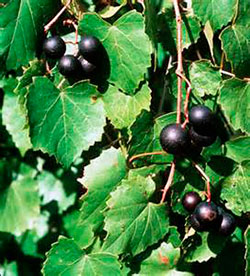 The muscadine grape (Vitis rotundifolia Michx.) is native to the southeastern United States and was the first native grape species to be cultivated in North America. The natural range of muscadine grapes extends from Delaware to central Florida and occurs in all states along the Gulf Coast to east Texas. Muscadine grapes will perform well throughout Florida, although performance is poor in high alkaline soils or in soils with very poor drainage. These grapes do not like to be in areas where water is likely to drain off slowly or near retention ponds. There are three species within the Muscadania subgenera (Vitis munsoniana, Vitis popenoei and Vitis rotundifolia ). Wild muscadine grapes are functionally dioecious meaning they have male and female vines. Male vines account for the majority of the wild muscadine grape population. Muscadine grapes are late in breaking bud in the spring and require 100-120 days to mature fruit. Typically, muscadine grapes in the wild bear dark fruit with usually 4 to 10 fruit per cluster. Bronze-fruited muscadine grapes are also found in the wild, and they are often referred to as scuppernongs. There are hundreds of named muscadine grape cultivars from improved selections, and in fact, one that has been found in the Scuppernong river of North Carolina has been named Scuppernong. So to directly answer your question, not all muscadines are Scuppernong but all Scuppernongs are muscadines and yours is a muscadine. How about that for a tongue twister! There are over 100 improved cultivars of muscadine grapes varying in size from 1/4 to 1 1/2 inches in diameter and 4 to 15 grams in weight. Skin color ranges from light bronze to pink to purple to black. Flesh is clear and translucent for all muscadine grape berries. One reason for the popularity of muscadine grapes is that they are a sustainable fruit crop in the southeastern United States. They are tolerant of insect and disease pests, and homeowners can successfully grow muscadine grapes without spraying any pesticides. For more complete information on planting, fertilization, pruning, etc. look over the following UF/IFAS publication: http://edis.ifas.ufl.edu/hs100
The muscadine grape (Vitis rotundifolia Michx.) is native to the southeastern United States and was the first native grape species to be cultivated in North America. The natural range of muscadine grapes extends from Delaware to central Florida and occurs in all states along the Gulf Coast to east Texas. Muscadine grapes will perform well throughout Florida, although performance is poor in high alkaline soils or in soils with very poor drainage. These grapes do not like to be in areas where water is likely to drain off slowly or near retention ponds. There are three species within the Muscadania subgenera (Vitis munsoniana, Vitis popenoei and Vitis rotundifolia ). Wild muscadine grapes are functionally dioecious meaning they have male and female vines. Male vines account for the majority of the wild muscadine grape population. Muscadine grapes are late in breaking bud in the spring and require 100-120 days to mature fruit. Typically, muscadine grapes in the wild bear dark fruit with usually 4 to 10 fruit per cluster. Bronze-fruited muscadine grapes are also found in the wild, and they are often referred to as scuppernongs. There are hundreds of named muscadine grape cultivars from improved selections, and in fact, one that has been found in the Scuppernong river of North Carolina has been named Scuppernong. So to directly answer your question, not all muscadines are Scuppernong but all Scuppernongs are muscadines and yours is a muscadine. How about that for a tongue twister! There are over 100 improved cultivars of muscadine grapes varying in size from 1/4 to 1 1/2 inches in diameter and 4 to 15 grams in weight. Skin color ranges from light bronze to pink to purple to black. Flesh is clear and translucent for all muscadine grape berries. One reason for the popularity of muscadine grapes is that they are a sustainable fruit crop in the southeastern United States. They are tolerant of insect and disease pests, and homeowners can successfully grow muscadine grapes without spraying any pesticides. For more complete information on planting, fertilization, pruning, etc. look over the following UF/IFAS publication: http://edis.ifas.ufl.edu/hs100
I think I have rust on my figs, what should I do?
Fig rust, caused by the fungus Cerotelium fici (formerly Physopella fici), is the most common disease of figs in most regions of the southeastern U.S. Fig rust occurs only on the leaves and does not affect the fruit directly. Rust generally develops late in the summer, and in years when disease is severe, it can cause the trees to defoliate in a matter of a few weeks. If this happens on a regular basis, the overall growth of the trees can be reduced and yields can be affected. Initially, symptoms of fig rust are visible as small, yellowish spots on the upper surface of the leaves. As these spots (or lesions) grow larger, they turn a reddish-brown color but remain relatively smooth. On the lower surface of the leaf, the lesions are a reddish-brown color and have a slightly raised, blister-like appearance. Heavily infected leaves often turn yellow or brown, particularly around the edges, and drop prematurely. There are no fungicides registered for use on edible figs in Florida so this is one of those conditions we call “grin and bear it.” It is important to remove and throw away infected leaves once they fall to the ground but little else can be done.

